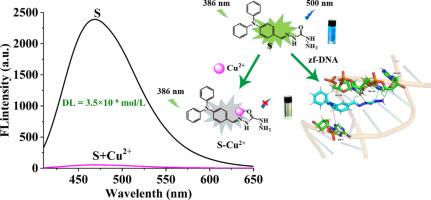Synthesis of a triphenylamine-based “ON-OFF” type fluorescent probe: Cu2+ detection, DNA binding studies and theoretical calculations
IF 4.6
2区 化学
Q1 SPECTROSCOPY
Spectrochimica Acta Part A: Molecular and Biomolecular Spectroscopy
Pub Date : 2025-09-22
DOI:10.1016/j.saa.2025.126953
引用次数: 0
Abstract
A Cu2+ fluorescent probe molecule (S) of the “ON-OFF” type was designed and synthesized using 4-(diphenylamino)benzaldehyde and carbohydrazide as starting materials. The structure of S was systematically characterized using IR spectroscopy, HRMS, 1H NMR, and 13C NMR. Spectroscopic experiments demonstrated that the binding stoichiometry of S to Cu2+ was 1:1, with remarkable selectivity and sensitivity for detecting Cu2+. Moreover, the detection limit of 3.5 × 10−8 mol⋅L−1 was significantly lower than those reported for previously developed fluorescent sensors targeting Cu2+. Density functional theory (DFT) and time-dependent DFT (TD-DFT) calculations revealed that Cu2+ ions coordinated with the imine nitrogen and carbonyl oxygen of the Schiff base, triggering a photoinduced electron transfer (PET) effect that quenched the fluorescence of Schiff base S. Furthermore, the interaction between S and zebrafish sperm DNA (zf-DNA) was investigated using a combination of spectroscopic methods, DNA binding assays (with both single- and double-stranded DNA), viscosity measurements, and molecular docking simulations. The findings revealed that the primary mode of interaction between S and zf-DNA was groove-face binding, which occurred spontaneously and was governed by hydrogen bonds, C![]() H interactions, π-π stacking, and van der Waals forces. In summary, the developed Schiff-base probe S demonstrates high sensitivity and selectivity for Cu2+ detection in complex environmental matrices. Moreover, this study advances the understanding of Schiff-base-DNA interactions and introduces a novel strategy for designing multifunctional sensors applicable to biomacromolecule detection and anticancer drug development.
H interactions, π-π stacking, and van der Waals forces. In summary, the developed Schiff-base probe S demonstrates high sensitivity and selectivity for Cu2+ detection in complex environmental matrices. Moreover, this study advances the understanding of Schiff-base-DNA interactions and introduces a novel strategy for designing multifunctional sensors applicable to biomacromolecule detection and anticancer drug development.

基于三苯胺的“ON-OFF”型荧光探针的合成:Cu2+检测、DNA结合研究和理论计算。
以4-(二苯胺)苯甲醛和碳酰肼为原料,设计并合成了一种“ON-OFF”型Cu2+荧光探针分子。利用红外光谱、HRMS、1H NMR和13C NMR对S的结构进行了系统表征。光谱实验表明,S与Cu2+的结合化学计量比为1:1,对Cu2+的检测具有显著的选择性和灵敏度。此外,检测限为3.5 × 10-8 mol⋅L-1,显著低于先前报道的针对Cu2+的荧光传感器。密度泛函数理论(DFT)和时间依赖DFT (TD-DFT)计算表明,Cu2+离子与希夫碱的亚胺氮和羰基氧配合,引发光致电子转移(PET)效应,猝灭希夫碱S的荧光。此外,利用光谱方法、DNA结合试验(单链和双链DNA)、粘度测量和分子对接模拟。结果表明,S和zf-DNA之间的主要相互作用模式是凹槽-面结合,这种相互作用是自发发生的,受氢键、CH相互作用、π-π堆积和范德华力的控制。综上所述,所开发的希夫碱探针S对复杂环境基质中Cu2+的检测具有较高的灵敏度和选择性。此外,本研究促进了对Schiff-base-DNA相互作用的理解,并为设计适用于生物大分子检测和抗癌药物开发的多功能传感器提供了一种新的策略。
本文章由计算机程序翻译,如有差异,请以英文原文为准。
求助全文
约1分钟内获得全文
求助全文
来源期刊
CiteScore
8.40
自引率
11.40%
发文量
1364
审稿时长
40 days
期刊介绍:
Spectrochimica Acta, Part A: Molecular and Biomolecular Spectroscopy (SAA) is an interdisciplinary journal which spans from basic to applied aspects of optical spectroscopy in chemistry, medicine, biology, and materials science.
The journal publishes original scientific papers that feature high-quality spectroscopic data and analysis. From the broad range of optical spectroscopies, the emphasis is on electronic, vibrational or rotational spectra of molecules, rather than on spectroscopy based on magnetic moments.
Criteria for publication in SAA are novelty, uniqueness, and outstanding quality. Routine applications of spectroscopic techniques and computational methods are not appropriate.
Topics of particular interest of Spectrochimica Acta Part A include, but are not limited to:
Spectroscopy and dynamics of bioanalytical, biomedical, environmental, and atmospheric sciences,
Novel experimental techniques or instrumentation for molecular spectroscopy,
Novel theoretical and computational methods,
Novel applications in photochemistry and photobiology,
Novel interpretational approaches as well as advances in data analysis based on electronic or vibrational spectroscopy.

 求助内容:
求助内容: 应助结果提醒方式:
应助结果提醒方式:


